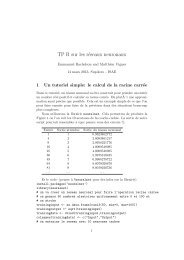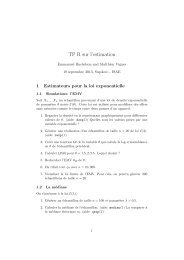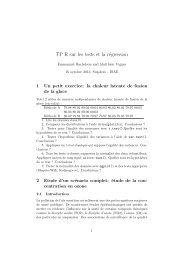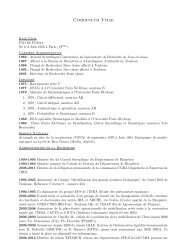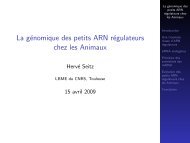Modeling the process of operational decision-making in ... - Inra
Modeling the process of operational decision-making in ... - Inra
Modeling the process of operational decision-making in ... - Inra
You also want an ePaper? Increase the reach of your titles
YUMPU automatically turns print PDFs into web optimized ePapers that Google loves.
Ripoche et al. 2011). At any time <strong>the</strong> <strong>in</strong>terpretation <strong>of</strong> such a plan determ<strong>in</strong>es what is permitted accord<strong>in</strong>g to <strong>the</strong><br />
plan and what is possible given <strong>the</strong> limitations <strong>of</strong> resources (labor, mach<strong>in</strong>ery etc.). Given <strong>the</strong> flexibility <strong>of</strong> <strong>the</strong><br />
plan this constra<strong>in</strong>t satisfaction phase yields several sets <strong>of</strong> actions. Each set is a candidate solution. The <strong>the</strong>sis<br />
work is focused on <strong>the</strong> problem <strong>of</strong> choos<strong>in</strong>g <strong>the</strong> preferable solution to execute among <strong>the</strong> candidate ones. This<br />
k<strong>in</strong>d <strong>of</strong> choice problem has to be repeated as <strong>of</strong>ten as required by <strong>the</strong> occurrence <strong>of</strong> disruptive events that <strong>in</strong>terrupt<br />
<strong>the</strong> execution <strong>process</strong> (typically at least once a day).<br />
The central question <strong>of</strong> <strong>the</strong> <strong>the</strong>sis proposal can be stated as: how is a farm manager cognitively approach<strong>in</strong>g<br />
<strong>decision</strong>s and how is he <strong>in</strong>tegrat<strong>in</strong>g constra<strong>in</strong>ts, desires and judgment. The central question <strong>in</strong>duces two types <strong>of</strong><br />
<strong>in</strong>vestigation to:<br />
- categorize and represent <strong>the</strong> heterogeneous types <strong>of</strong> <strong>in</strong>formation taken <strong>in</strong>to account <strong>in</strong> <strong>the</strong> <strong>decision</strong>-<strong>mak<strong>in</strong>g</strong><br />
<strong>process</strong>, and determ<strong>in</strong>e how such relevant <strong>in</strong>formation can be dynamically ga<strong>the</strong>red or constructed at every<br />
<strong>decision</strong> stage;<br />
- formalize and model <strong>the</strong> <strong>decision</strong> <strong>process</strong> by which such <strong>in</strong>formation can be manipulated and comb<strong>in</strong>ed.<br />
Instantiated cases <strong>of</strong> this <strong>process</strong> should bear strong resemblance with <strong>the</strong> choice procedures observed or<br />
imag<strong>in</strong>able <strong>in</strong> real situations.<br />
In agriculture <strong>operational</strong> production management has to deal with: (1) a series <strong>of</strong> <strong>in</strong>terdependent <strong>decision</strong>s and/or<br />
actions (today’s choices have to be made <strong>in</strong> coherence with those made previously); (2) constantly chang<strong>in</strong>g<br />
situations; (3) shift<strong>in</strong>g goals and preferences. The potentially relevant pieces <strong>of</strong> <strong>in</strong>formation that drive <strong>the</strong> <strong>decision</strong><br />
<strong>process</strong> need to be extracted or even constructed for every choice task. That is, farmers need to get preferences<br />
and beliefs on <strong>the</strong> spot when needed, <strong>in</strong>stead <strong>of</strong> hav<strong>in</strong>g known, well-def<strong>in</strong>ed, and stable ones. In order to be able to<br />
understand differences between management behaviors one has first to <strong>in</strong>dentify <strong>the</strong> types <strong>of</strong> <strong>in</strong>formation <strong>in</strong>voked,<br />
<strong>the</strong>ir role <strong>in</strong> <strong>the</strong> <strong>decision</strong> <strong>process</strong> and <strong>the</strong> way <strong>the</strong>y are dynamically acquired.<br />
The choice <strong>process</strong> <strong>in</strong>volves <strong>in</strong>formation sources that <strong>in</strong>duce a restriction <strong>of</strong> <strong>the</strong> set <strong>of</strong> candidate solutions (for<br />
<strong>in</strong>stance, non urgent candidate solutions can be discarded if o<strong>the</strong>rs are urgent). Contrast<strong>in</strong>gly, o<strong>the</strong>r factors taken<br />
<strong>in</strong>to account <strong>in</strong> <strong>the</strong> choice (e.g. cost or expected efficiency) <strong>in</strong>fluence <strong>the</strong> result by modify<strong>in</strong>g <strong>the</strong> strength <strong>of</strong><br />
preference <strong>of</strong> a particular solution over <strong>the</strong> o<strong>the</strong>rs. The choice <strong>process</strong> amounts to a multifactorial evaluation <strong>of</strong><br />
arguments aga<strong>in</strong>st or <strong>in</strong> favor <strong>of</strong> <strong>the</strong> candidate solution. Of course, uncerta<strong>in</strong>ty about <strong>the</strong> actual state (due to<br />
observation difficulties) or future events (wea<strong>the</strong>r essentially) may affect <strong>the</strong> farmer’s choice <strong>process</strong>, which as<br />
usual, <strong>in</strong>volves trad<strong>in</strong>g-<strong>of</strong>f between what ought to be (goals) and what can be (belief). The <strong>decision</strong> <strong>process</strong> is also<br />
responsible <strong>of</strong> direct<strong>in</strong>g or ma<strong>in</strong>ta<strong>in</strong><strong>in</strong>g <strong>the</strong> cont<strong>in</strong>uous flow <strong>of</strong> management behavior toward overall production<br />
objectives (it is not solely a set <strong>of</strong> <strong>in</strong>dependent episodes <strong>in</strong>volv<strong>in</strong>g choices dilemmas). To be faithful to <strong>the</strong> reality,<br />
<strong>the</strong> choice <strong>process</strong> <strong>in</strong> our model has to <strong>in</strong>volve little <strong>process</strong><strong>in</strong>g <strong>in</strong> order to be compatible with <strong>the</strong> paucity <strong>of</strong><br />
<strong>in</strong>formation and <strong>the</strong> fast pace <strong>of</strong> <strong>decision</strong>-<strong>mak<strong>in</strong>g</strong> observed <strong>in</strong> farmers’ practices.<br />
3 Le contexte méthodologique choisi et les développements envisagés<br />
Traditional studies <strong>of</strong> <strong>decision</strong>-<strong>mak<strong>in</strong>g</strong> <strong>in</strong> economics, operations research and artificial <strong>in</strong>telligence have tended to<br />
view <strong>decision</strong>-maker as possess<strong>in</strong>g supernatural powers <strong>of</strong> reason with limitless mental resources and full,<br />
<strong>in</strong>formation to apply a particular pr<strong>in</strong>ciple <strong>of</strong> rationality. Indeed perfect rationality is a crucial assumption <strong>in</strong><br />
economics that assume agents make <strong>the</strong>ir <strong>decision</strong>s coherently with <strong>the</strong> utility maximization doctr<strong>in</strong>e. Actually,<br />
Expected Utility (EU) <strong>the</strong>ory rema<strong>in</strong>s <strong>the</strong> dom<strong>in</strong>ant approach for model<strong>in</strong>g risky <strong>decision</strong> <strong>mak<strong>in</strong>g</strong> and is still <strong>the</strong><br />
paradigm <strong>of</strong> reference <strong>in</strong> <strong>decision</strong> <strong>mak<strong>in</strong>g</strong>. This framework addresses <strong>decision</strong> problems <strong>in</strong> which <strong>the</strong> <strong>decision</strong><br />
sett<strong>in</strong>g does not change (goals do not shift or need not be redef<strong>in</strong>ed) and <strong>the</strong> <strong>decision</strong> options and consequences<br />
are completely known or assumed so. Despite its normative appeal, <strong>the</strong> EU framework has come under <strong>in</strong>tense<br />
scrut<strong>in</strong>y because <strong>of</strong> its <strong>in</strong>ability to describe some features <strong>of</strong> <strong>in</strong>dividual behaviour under risk as shown by several<br />
experiments and empirical observations. Several studies have proposed more general <strong>the</strong>oretical frameworks such<br />
as <strong>the</strong> Kahneman and Tversky's prospect <strong>the</strong>ory (1992) that dist<strong>in</strong>guishes between preferences <strong>in</strong> <strong>the</strong> ga<strong>in</strong> and <strong>in</strong><br />
<strong>the</strong> loss doma<strong>in</strong>s and assumes that <strong>the</strong> objective function is non l<strong>in</strong>ear <strong>in</strong> probability. However all <strong>the</strong>se <strong>the</strong>ories<br />
adhere to <strong>the</strong> paradigm <strong>of</strong> perfect rational <strong>decision</strong>-maker. Moreover, <strong>the</strong> EU model has also been criticized on <strong>the</strong><br />
fram<strong>in</strong>g aspect: <strong>the</strong> difficulty <strong>of</strong> gett<strong>in</strong>g <strong>the</strong> options, probability, and utility values.<br />
In a complex and uncerta<strong>in</strong> world, humans make <strong>decision</strong>s under <strong>the</strong> constra<strong>in</strong>ts <strong>of</strong> limited knowledge and<br />
cognitive <strong>process</strong><strong>in</strong>g resources. Yet classical models <strong>of</strong> rational <strong>decision</strong> <strong>mak<strong>in</strong>g</strong> ignore <strong>the</strong> importance <strong>of</strong> <strong>the</strong>se<br />
real constra<strong>in</strong>ts and <strong>in</strong>stead assume agents with perfect <strong>in</strong>formation and unlimited time. In his sem<strong>in</strong>al work,<br />
Herbert Simon (Simon 1976) challenged this view with his notion <strong>of</strong> "bounded rationality" He <strong>in</strong>troduced <strong>the</strong><br />
notion <strong>of</strong> satisfic<strong>in</strong>g, contend<strong>in</strong>g that <strong>decision</strong>-makers deal with real-world complexity by us<strong>in</strong>g procedures that<br />
f<strong>in</strong>d ‘‘good enough’’ answers to questions when best answers cannot be obta<strong>in</strong>ed. There is general agreement<br />
among psychologists that <strong>the</strong>re are limits to our <strong>process</strong><strong>in</strong>g ability. Many approaches to <strong>the</strong> study <strong>of</strong> judgment<br />
have emphasized simplicity and limited computation <strong>in</strong> account<strong>in</strong>g for agents’ behavior (Cozic 2008; Mong<strong>in</strong><br />
1986; Laville 1998; Selten 1998; Walliser 2008). Follow<strong>in</strong>g Simon, a behavioral science framework, called



